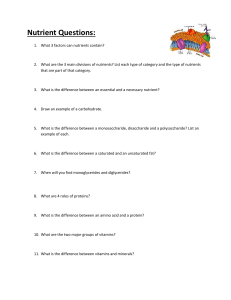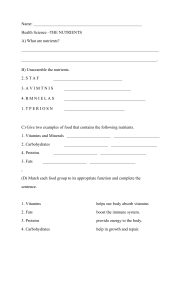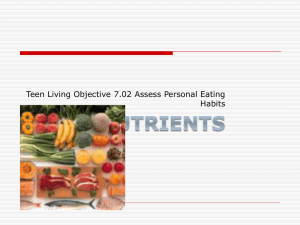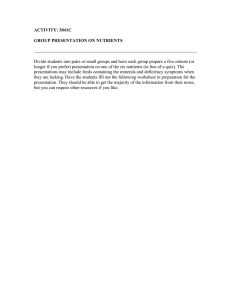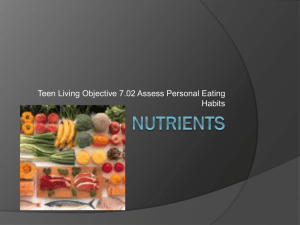Animal Nutrition Lecture Notes: Terminology & Nutrients
advertisement
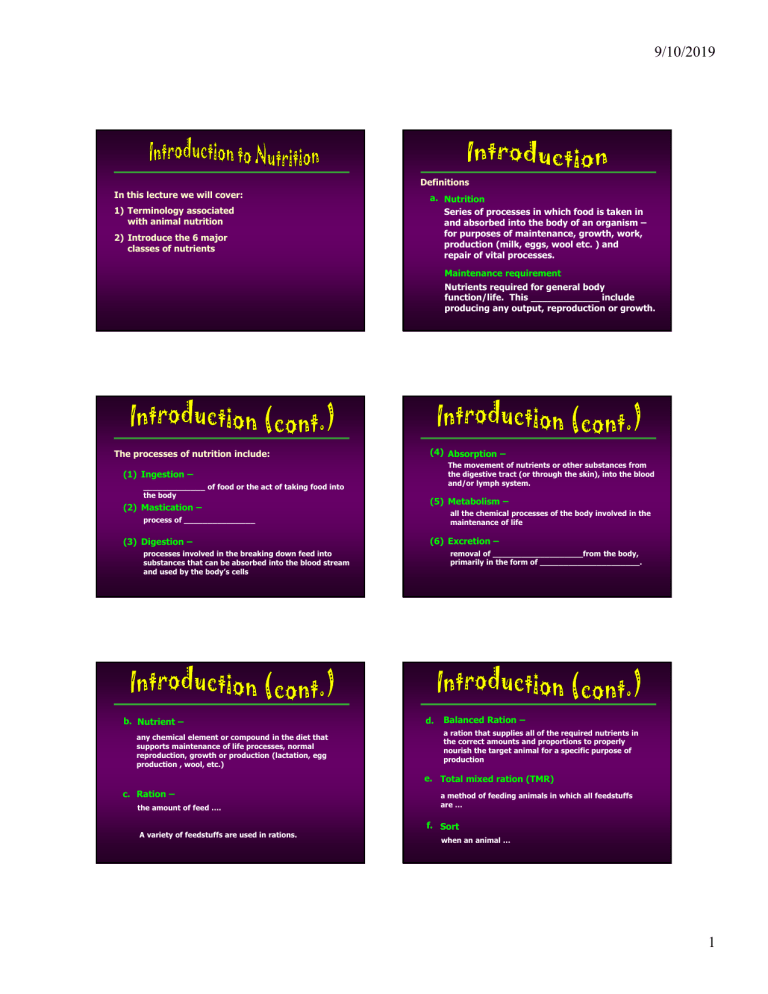
9/10/2019 Definitions In this lecture we will cover: 1) Terminology associated with animal nutrition 2) Introduce the 6 major classes of nutrients a. Nutrition Series of processes in which food is taken in and absorbed into the body of an organism – for purposes of maintenance, growth, work, production (milk, eggs, wool etc. ) and repair of vital processes. Maintenance requirement Nutrients required for general body function/life. This ____________ include producing any output, reproduction or growth. The processes of nutrition include: (4) Absorption – The movement of nutrients or other substances from the digestive tract (or through the skin), into the blood and/or lymph system. (1) Ingestion – _____________ of food or the act of taking food into the body (2) Mastication – (5) Metabolism – all the chemical processes of the body involved in the maintenance of life process of _______________ (3) Digestion – (6) Excretion – removal of ___________________from the body, primarily in the form of _____________________. processes involved in the breaking down feed into substances that can be absorbed into the blood stream and used by the body’s cells b. Nutrient – any chemical element or compound in the diet that supports maintenance of life processes, normal reproduction, growth or production (lactation, egg production , wool, etc.) d. Balanced Ration – a ration that supplies all of the required nutrients in the correct amounts and proportions to properly nourish the target animal for a specific purpose of production e. Total mixed ration (TMR) c. Ration – the amount of feed …. A variety of feedstuffs are used in rations. a method of feeding animals in which all feedstuffs are … f. Sort when an animal … 1 9/10/2019 g. Ad Libitum (free choice) – Animals are able to access at any time. Water for example, should be provided free-choice. Other feed ingredients can be also be provided free choice. One common example is minerals. While minerals can be included in a TMR, they can also be fed free choice in blocks. This allows animals to lick them any time they choose. h. Feed/feedstuff – refers to food but is more commonly applied to animal food than to human food k. Feed additive – __________________________________________ __________________________________________ by an animal. They are primarily included in diets to improve the health, productivity, and profitability of the animal. Water Concentrate – i. Concentrates include energy rich grains (ex. corn) or protein rich grains (ex. soybeans), byproduct feeds, vitamins and minerals. j. Forage/Roughage– Forages include grasses, legumes (alfalfa) and silages (corn silage, haylage etc.). Forages are higher in fiber and lower in energy compared to concentrates such as corn or soybeans. What Nutrients Do Animals Need? There are Six Major Classes water, protein, carbohydrates, fats, minerals and vitamins General Description of Six Classes of Nutrients Various functions: • transports nutrients and aids in excretion 1) Water – ___________________________ a) • medium that allows chemical reactions b) 65 to 85% of animal body weight at _________ and 45 to 65% of body weight at _____________ c) percentage of body water ___________ with animal age and has an _____________ relationship with body fat • body temperature regulation • lubricates joints and organs in body cavity Accounts for: 90 to 95% of blood 70 to 90% of tissues 2 9/10/2019 2) Carbohydrates 3) Lipids (Fats) a) The __________________ in animal diets a) defined as insoluble in water but soluble in organic solvents b) Generally classified in animal nutrition as either structural (fibrous) or non-structural (non-fibrous). b) fat sources can be plant or animal based. c) c) required for absorption of fat soluble vitamins d) Structural carbohydrates (such as forages) are a source of energy and a source of bulk (important to keep the digestive tract working smoothly) Examples of non-structural carbohydrates include starches (from grains such as corn, oat, milo) and sugars. 4) Proteins a) Made up of amino acids which are required for tissues and muscle production. b) Protein sources in diets can be animal (blood meal, fish meal, meat and bone meal) or plant based (soybean meal, canola meal, cottonseed, alfalfa). c) Twenty-two amino acids are commonly found in proteins, 10 are required in the animal diet. These are __________________________ because the animal body cannot synthesize them fast enough to meet its requirement. 5) Minerals c) Excess minerals in diets can decrease animal performance, or result in toxicity and/or death. For example, sheep are particularly sensitive to high copper levels. d) most ________________ nutrient One gram of fat yields about 9.45 kcal gross energy (heat) compared with 4.2 kcal for a typical CHO. 5) Minerals a) ______________ compounds required for normal growth of bones, teeth and tissue. Additionally they are important for many of the body’s chemical processes. Included in small quantities in diets. b) Total mineral content of plants or animals is called ______________ Macrominerals: essential elements required in relatively large amounts – Ca, P, Na, Cl, Mg, K Microminerals: trace elements required in much smaller amounts – Co, Cu, F, I, Fe, Mn, Mo, Se, Zn 6) Vitamins – fat and water soluble a) __________________ compounds required in small quantities b) Required for normal digestion, cell metabolism, growth and reproduction. c) classified as ________________________ d) Vitamins can be obtained from feedstuffs and/or added to diets (dependent on requirement). 3
